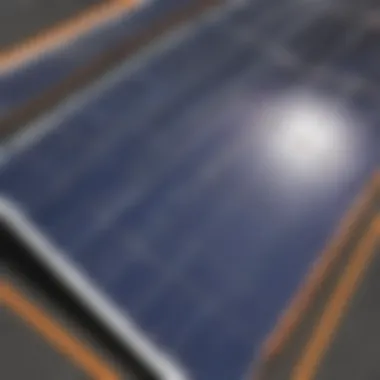Uncovering Cutting-Edge Solar Energy Innovations for a Sustainable Future


Science Fun Facts
Solar energy, derived from the sun's radiation, is a remarkable source of renewable energy. Did you know that the Earth receives enough sunlight in one hour to meet global energy needs for an entire year? This astounding fact showcases the immense potential of solar power in revolutionizing our energy landscape.
Discover the Wonders of Science
Embark on a journey to explore the various scientific concepts behind solar energy. Through engaging educational videos and animations, discover how sunlight is converted into electricity through solar panels. Delve into the real-life applications of solar energy, from powering homes to sustainable modes of transportation.
Science Quiz Time
Put your knowledge to the test with interactive quizzes on solar energy. Challenge yourself with multiple-choice questions that delve into the intricacies of solar power generation and its environmental impact. Stimulate your mind with brain teasers and puzzles centered around the principles of renewable energy.
Science Experiment Showcase
Engage in fun and educational experiments that demonstrate the principles of solar energy conversion. Follow step-by-step instructions to build a simple solar-powered device using readily available materials. Prioritize safety with essential tips and precautions to ensure a secure and enriching experimental experience.


Harnessing Solar Energy for a Sustainable Future
Solar energy, a potent force harnessed from the sun, holds paramount significance in our quest for a sustainable future. This pivotal topic encapsulates the essence of clean, renewable energy sources that steer us away from the shackles of fossil fuels. Embracing solar energy entails a myriad of benefits, ranging from reduced carbon emissions to a diminished reliance on non-renewable resources. As we plunge into the realm of harnessing solar energy for a sustainable future, factors like cost-effectiveness, environmental preservation, and long-term sustainability emerge as pivotal considerations. The technological advancements in solar energy not only propel us towards a greener tomorrow but also pave the way for a more energy-efficient and eco-conscious society.
Solar-Powered Transportation Innovations
Advancements in Solar-Powered Vehicles
The realm of advancements in solar-powered vehicles is a realm of technological marvels. These vehicles harness the sun's energy to power their movement, symbolizing an eco-friendly alternative to traditional fuel-powered transportation. Their key characteristic lies in their ability to convert sunlight into usable energy, reducing carbon footprints and lessening environmental impact. The seamless integration of solar panels into these vehicles embodies a blend of innovation and sustainability, making them a favorable choice in our exploration of solar energy innovations. However, as with any technological advancement, there exist nuances such as limitations in power generation during non-daylight hours and potential constraints in scalability, underscoring the need for further research and development.
Solar-Powered Public Transportation Systems
Solar-powered public transportation systems epitomize a shift towards sustainable urban mobility. These systems offer a holistic approach to transportation, utilizing solar energy to power buses, trams, and trains, among other modes of commute. The key characteristic of these systems lies in their ability to reduce greenhouse gas emissions and enhance energy efficiency within urban settings. By leveraging solar power, these transportation systems emerge as a favorable choice for our article, showcasing a commitment to eco-conscious practices and the promotion of renewable energy adoption. However, challenges may arise in terms of initial infrastructure costs and the need for comprehensive city planning to facilitate seamless integration.
Solar-Powered Charging Stations


Solar-powered charging stations represent a cornerstone in our transition towards sustainable energy infrastructure. By harnessing solar energy to charge electric vehicles, these stations offer a green alternative to conventional petrol stations. Their key characteristic resides in their ability to provide clean energy for electric vehicles on the go, reducing dependency on traditional fossil fuels. The unique feature of these charging stations lies in their accessibility and potential to revolutionize the electric vehicle industry. Despite their advantageous contributions to our article, issues such as intermittency of solar power and grid compatibility complexities may pose challenges that necessitate innovative solutions for seamless operation.
Stay tuned for the exploration of Revolutionary Solar Panel Technologies in the upcoming sections.
Exploring Solar Energy Applications in Various Sectors
In this article, delving into solar energy applications across various sectors unfolds a vibrant landscape of innovation and sustainability. Understanding the pivotal role of solar energy in agriculture, architecture, gadgets, and remote areas becomes paramount in today's eco-conscious world. Solar energy applications, driven by technology and environmental consciousness, offer a myriad of benefits from efficiency to cost-effectiveness. Embracing solar energy solutions in various sectors holds the potential to transform our energy landscape into a more sustainable and eco-friendly one.
Solar-Powered Agriculture
Solar-Powered Agriculture signifies a paradigm shift in farming practices, integrating renewable energy for efficient operations. Solar-Powered Irrigation Systems stand out as a cornerstone of this agricultural revolution, harnessing solar power to irrigate crops sustainably. The key characteristic of Solar-Powered Irrigation Systems lies in their ability to reduce reliance on non-renewable energy sources, promoting environmental sustainability. A unique feature of such systems is their adaptability to remote locations, showcasing their reliability and versatility.
Photovoltaic Greenhouses represent another pioneering aspect of Solar-Powered Agriculture, combining greenhouse farming with solar energy production. This integrated approach not only provides optimal growing conditions but also generates clean energy for sustainable farming practices. The distinctive feature of Photovoltaic Greenhouses lies in their dual functionality, fostering crop growth while producing renewable energy. Despite some limitations, such as initial setup costs, their advantages in promoting energy efficiency and agricultural sustainability make them a popular choice.
The incorporation of Solar-Powered Crop Drying techniques in agricultural processes further exemplifies the evolution towards sustainable practices. By using solar energy to dry crops, farmers reduce dependence on fossil fuels, lowering both costs and carbon footprints. Solar-Powered Crop Drying's standout characteristic is its ability to preserve crop quality while minimizing environmental impact. Though facing some challenges like weather dependence, its benefits in energy conservation and crop preservation make it a favorable option in sustainable agriculture.


Solar Energy Innovations in Architecture
Solar Energy's integration into architecture marks a revolutionary approach towards energy-efficient and environmentally friendly buildings. Solar Skin Facades offer a visually appealing and functional addition to architectural designs, utilizing solar panels as building claddings. The key characteristic of Solar Skin Facades lies in their ability to generate renewable energy while enhancing the building's aesthetics. A unique feature of this innovation is its seamless integration, providing both form and function in sustainable architecture.
BIPV (Building-Integrated Photovoltaics) represent another cutting-edge application of solar energy in architecture, seamlessly embedding solar panels into building structures. The essential characteristic of BIPV is their ability to merge energy generation with architectural design, creating self-sustaining buildings. The unique feature of BIPV lies in their versatility, offering architects creative freedom in incorporating solar technology. Despite facing challenges related to initial costs, their advantages in energy efficiency and design flexibility make them a popular choice in sustainable architecture.
Solar-Powered Smart Windows stand at the forefront of solar energy innovations in architecture, transforming traditional windows into energy-producing assets. These technologically advanced windows harness sunlight to generate electricity while maintaining transparency and insulation. The key characteristic of Solar-Powered Smart Windows lies in their dual functionality, providing natural light and energy efficiency. A unique feature of these windows is their smart technology, allowing for automatic adjustment based on sunlight intensity and building needs. Despite some drawbacks in terms of cost, their benefits in energy savings and building sustainability position them as a top choice for modern architecture.
Solar-Powered Gadgets and Devices
Solar energy's expansion into gadgets and devices showcases a growing trend towards portable and eco-friendly technologies. Solar-Powered Wearables represent a novel fusion of fashion and functionality, incorporating solar panels into wearable tech for on-the-go power generation. The key characteristic of Solar-Powered Wearables is their versatility, offering users a sustainable way to charge electronic devices while being fashionable. A unique feature of these wearables is their convenience, allowing users to harness solar energy in everyday activities. Despite limitations in power output, their advantages in promoting sustainability and personal energy independence make them an attractive choice for eco-conscious consumers.
Portable Solar Chargers serve as a practical solution for harnessing solar energy on-the-go, providing a convenient power source for electronic devices. These compact devices leverage solar panels to convert sunlight into electricity, offering a sustainable charging option in various settings. The key characteristic of Portable Solar Chargers is their portability, enabling users to charge devices anywhere there is sunlight. A unique feature of these chargers is their environmental friendliness, reducing the need for traditional power sources when traveling or outdoors. Despite some limitations in charging speed, their advantages in promoting renewable energy usage and convenience make them a popular choice among outdoor enthusiasts and technology users.
Solar-Powered Outdoor Lighting illuminates pathways and outdoor spaces with renewable energy, offering a greener alternative to traditional lighting systems. These solar-powered lights derive energy from the sun to automatically illuminate outdoor areas after dusk. The key characteristic of Solar-Powered Outdoor Lighting is their independence from the grid, providing a sustainable lighting solution for gardens, walkways, and other outdoor areas. A unique feature of these lights is their ease of installation and maintenance, requiring no wiring or external power source. Despite variations in brightness based on sunlight exposure and initial setup costs, their advantages in energy savings and environmental impact make them a popular choice for eco-friendly outdoor lighting.
Solar Energy Solutions in Remote Areas
Bringing solar energy solutions to remote areas addresses energy access challenges and promotes sustainability in off-grid environments. Solar Microgrids emerge as a practical and scalable solution for providing electricity to communities located in remote or developing regions. The key characteristic of Solar Microgrids is their ability to decentralize energy production, offering a reliable power source to off-grid populations. A unique feature of these microgrids is their modularity, allowing for easy expansion based on energy needs. Despite potential constraints related to maintenance and upfront costs, the benefits of energy independence and community empowerment make Solar Microgrids a valuable asset in remote areas.
Off-Grid Solar Systems represent a self-sustaining energy solution for locations without access to centralized power grids, utilizing solar panels and batteries for electricity generation and storage. The essential characteristic of Off-Grid Solar Systems is their autonomy, enabling users to manage their energy consumption and production independently. A unique feature of these systems is their versatility, catering to diverse energy needs in remote areas. Despite challenges such as limited storage capacity and occasional maintenance requirements, their advantages in promoting energy reliability and independence make Off-Grid Solar Systems an effective choice for off-grid communities.
Solar-Powered Water Purification technology plays a vital role in ensuring clean drinking water availability in remote areas by utilizing solar energy to treat and purify water. The key characteristic of Solar-Powered Water Purification lies in its ability to provide sustainable and eco-friendly solutions to water scarcity issues. A unique feature of this technology is its independence from external power sources, making it suitable for remote locations with limited access to electricity. Despite challenges related to initial setup costs and water treatment capacity, its benefits in promoting health and environmental sustainability make Solar-Powered Water Purification an indispensable tool in remote area development.







